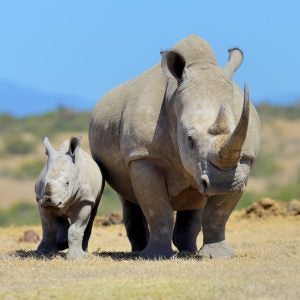
What is trophy hunting? How is it different from other types of hunting?
Trophy hunters pay huge sums of money to travel around the world and kill wild animals with the primary motivation of obtaining part of the animal for in-home display as a full mount, carpet or wall decoration. They also enter their achievements into record books kept by trophy hunting member organizations.
What kinds of animals are trophy hunted and where?
Between 2005 and 2014, more than 1.26 million wildlife trophies were imported to the U.S. alone — an average of more than 126,000 every year. Most originated in Canada and South Africa, with others coming from Namibia, Mexico, Zimbabwe, New Zealand, Tanzania, Argentina, Zambia, Botswana and elsewhere.
The death toll included American black bear, impala, common wildebeest, greater kudu, gemsbok, plains zebra, red deer, and warthog, along with the “Africa Big Five”: African lion, African elephant, African leopard, southern white rhino, and African buffalo.
What are the problems with trophy hunting? What about the argument that it can be used to support conservation?
Many animals, including the “Africa Big Five,” are killed in countries (such as Tanzania and Zimbabwe) with widespread corruption that prevents money raised from trophy hunting from benefiting conservation efforts, as hunters claim it does. There are problems with trophy hunting even in countries that do not face the same corruption issues. In the U.S., state wildlife agencies privilege the management of species like elk and deer to ensure they can be hunted and consumed, bringing in revenue. Even some states where large carnivore populations are in peril have permitted a trophy hunt of these animals. An example is Nebraska, which is estimated to have 20 surviving mountain lions, but authorized a hunt in 2014.
Trophy hunters prefer to kill the largest and the strongest animals, usually males with impressive manes, tusks, horns, etc. But these animals are endowed with the best genes for survival and once killed, their strong genes are lost to future generations.
The social biology of some species means that killing the strongest male will result in scores of additional deaths. For example, when a dominant African lion is killed, he leaves females and cubs vulnerable to a hostile pride takeover from another male, in which case the new male will kill the cubs of the previous lion.
Killing the strongest males may also negatively impact people. When dominant males are killed, juveniles who are more daring and less experienced and prone to killing livestock may move into the area.
Do different countries have different laws concerning trophy hunting?
Kenya, once a top destination for international hunters, banned trophy hunting in 1977, mainly because of declining wildlife populations, corruption and mismanagement of trophy hunting, lack of adequate law enforcement and habitat destruction. Other countries that prohibit trophy hunting include Malawi, Costa Rica, India and more.
Australia, the Netherlands, Finland and France prohibit trophy imports of varying species, while the U.S. is currently considering putting in place stricter requirements for elephant imports.
What about canned hunting?
Trophy hunting is also plagued by the issue of “canned hunting.” In South Africa, government reports estimate that there may be as many as 6,000 lions in commercial operations that essentially breed lions to be shot. The lions killed are nearly all bred and raised by private operations before they are placed in small “conservancies” to be shot by wealthy Americans.This makes a mockery of the idea of “fair chase” and even the Professional Hunters Association of South Africa announced in 2015 that it would no longer tolerate this form of hunting.
What is HSI doing to stop trophy hunting?
- HSI communicates the facts to the public, lawmakers and regulatory agencies. Our research reports include Trophy Hunting by the Numbers: The United States’ Role in Global Trophy Hunting and The $200 Million Question: How Much Does Trophy Hunting Really Contribute to African Communities?
- Knowing that most of the world’s trophy hunters are American, we have been pushing for greater protection under the Endangered Species Act in order to limit or prohibit trophy imports of animals sought by trophy hunters.
- We encourage state legislatures to institute measures to stop import, export and transportation of hunting trophies.
- We are also pressing to end corporate sponsorship of groups that promote trophy hunting, like Safari Club International, and to convince companies not to serve trophy hunters’ interests. For example, in the wake of Cecil the lion’s death, we helped convince 45 airlines to ban trophy imports of the “Africa Big Five.”
- We have long worked to improve protection under a global treaty, CITES, the Convention on International Trade in Endangered Species of Wild Fauna and Flora. We are focused on the species most targeted by trophy hunters, including elephants, lions, rhinos, leopards and others.
What is the eventual goal? How can people help?
Our ultimate goal is to bring trophy hunting around the world to an end. You can help by signing our petitions to airlines and shipping companies to stop transporting hunting trophies. You can also support the CECIL Act (Conserving Ecosystems by Ceasing the Importation of Large Animal Trophies Act) by calling your representative in Congress and expressing your strong wish to have it passed. Finally, you can donate to support our Stop Wildlife Abuse campaign.
